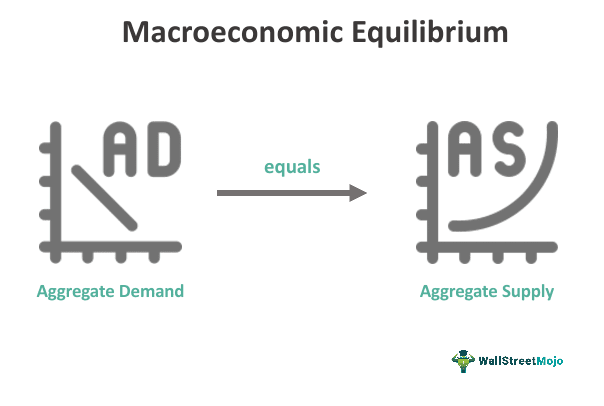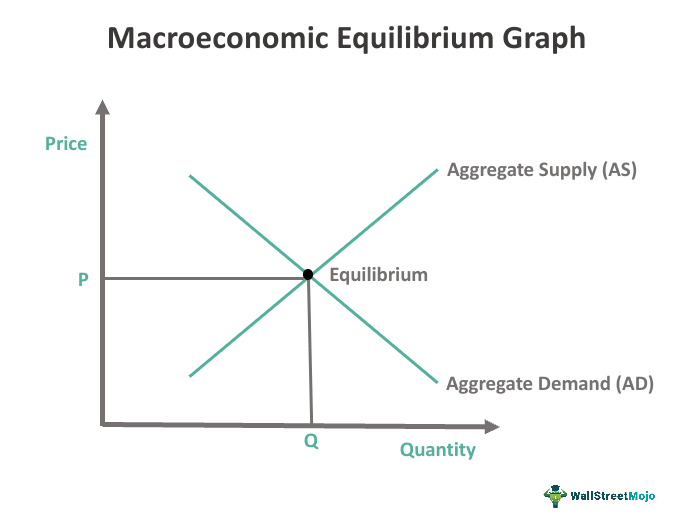What Is Macroeconomic Equilibrium?
Macroeconomic equilibrium is the intersection of aggregate demand and supply curves, symbolizing the point where demand aligns with production. This equilibrium acts as a crucial benchmark for economic stability, ensuring a balance between supply and demand to avert issues like inflation or unemployment.

You are free to use this image on your website, templates, etc, Please provide us with an attribution linkHow to Provide Attribution?Article Link to be Hyperlinked
For eg:
Source: Macroeconomic Equilibrium (wallstreetmojo.com)
Governments and economists leverage this equilibrium to evaluate and steer a nation’s economic performance. Policymakers strategically adjust aggregate demand, playing a vital role in economic forecasting and modeling. If inflation rises, policymakers shift aggregate demand using the right monetary policy, demonstrating the significance of this equilibrium in shaping economic policies.
Table of contents
Key Takeaways
- Macroeconomic equilibrium at the aggregate demand and supply curve intersection signifies a balance between demand and production, indicating economic stability that prevents inflation or unemployment disparities.
- Its major types include full employment, recessionary, inflationary, neoclassical, stagnation, long-run, and short-run equilibriums.
- Its graph illustrates key economic factors – Aggregate Demand (AD) and Aggregate Supply (AS) – intersecting at point R to signify macroeconomic equilibrium.
- Short-run macroeconomic equilibrium occurs when aggregate demand equals aggregate supply. In contrast, long-run macroeconomic equilibrium represents the point where aggregate demand meets aggregate supply after all long-term adjustments are made.
Macroeconomic Equilibrium Explained
Macroeconomic equilibrium occurs when aggregate demand equals aggregate supply, signifying that producers meet the demands of the government, businesses, and households. It’s a vital metric for assessing overall economic stability.
Economists, including influential figures like Milton Friedman and John Maynard Keynes, have contributed to its development. While Keynesian economics advocates for government intervention, under Friedman’s influence, neoclassical economics emphasizes market forces achieving equilibrium without direct intervention.
The equilibrium point indicates optimal price and output levels, influencing production, inflation control, and efficient resource utilization. Government interventions via monetary and fiscal policies become instrumental in addressing imbalances such as unemployment or inflationary gaps. Macroeconomic equilibrium is a pivotal concept, offering insights into economic operations and guiding the management strategies of governments and central banks.
Financial Modeling & Valuation Courses Bundle (25+ Hours Video Series)
–>> If you want to learn Financial Modeling & Valuation professionally , then do check this Financial Modeling & Valuation Course Bundle (25+ hours of video tutorials with step by step McDonald’s Financial Model). Unlock the art of financial modeling and valuation with a comprehensive course covering McDonald’s forecast methodologies, advanced valuation techniques, and financial statements.
Types
It depicts an equilibrium state of an economy where the goods or services produced equal the demand for them. Hence, one must know its major types as listed below:
- Full employment equilibrium: It may be considered an ideal form of equilibrium. Here, one has a job, and the economy is at the optimum production level.
- Recessionary gap equilibrium: The aggregated supply is more than the aggregated demand. As a result, the country faces economic slowdown and unemployment.
- Inflationary gap equilibrium: Here, the aggregated demand is more than the aggregated supply. Consequently, the country suffers from price rises and an overheated economy.
- Keynesian macroeconomic equilibrium: It can happen at any level of employment, making the total spending in an economy equal to total production.
- Neoclassical equilibrium: It focuses on efficient resource allocation and the key market force’s roles in reaching equilibrium.
- Stagnation equilibrium: It has its roots in inadequate investment, constant demand deficiencies and structural weakness in a nation’s economy. The nation is embroiled in an era of underutilized resources, low growth, and high unemployment.
- Long-run equilibrium: Here, all the long-term factors are considered to reach equilibrium, like economic adjustments, technological variations, labor force and capital stock.
- Short-run equilibrium: It concentrates on an immediate equilibrium between demand and supply without long-term adjustments.
- The classical model of macroeconomic equilibrium: It emphasizes that, in the long run, an economy naturally achieves full employment and price stability through flexible wages and prices.
Graph
Let’s look at the following graph to understand the concept better:

You are free to use this image on your website, templates, etc, Please provide us with an attribution linkHow to Provide Attribution?Article Link to be Hyperlinked
For eg:
Source: Macroeconomic Equilibrium (wallstreetmojo.com)
Within the graphical representation, the Aggregate Demand (AD) line delineates consumer preferences, embodying desired purchases, while the Aggregate Supply (AS) line portrays the entirety of goods and services in production. The pivotal juncture where these lines intersect is denoted as the equilibrium Point. The equilibrium point signifies the precise alignment of consumer demand with production quantity. Any deviation from this point suggests an economic imbalance, prompting economists to engage in remedial measures for restoring equilibrium.
Examples
Let us use a few examples to understand the topic.
Example #1
In the wake of the COVID-19 pandemic, the U.S. economy experienced a negative supply shock, resulting in a significant contraction in output and income. This shift in the aggregate supply curve led to a downward movement along the aggregate demand curve, illustrating a scenario of macroeconomic disequilibrium. The government implemented a $2 trillion economic stimulus package to address this, employing fiscal and monetary policies to counter the downturn.
While these measures provided some relief, the text emphasizes that full economic recovery requires the containment of the pandemic and a return to near-normal productivity levels. The example highlights the interplay of aggregate supply and demand, demonstrating the Keynesian perspective on macroeconomic equilibrium during a crisis.
Example #2
Imagine a small town where people buy and sell goods. When everyone in the town is happily trading, and the amount of stuff people want to buy equals the amount produced, that’s like the town’s economic sweet spot—it’s in macroeconomic equilibrium. But if suddenly folks start buying less or making fewer things, it’s like the town is out of balance. And that’s when governments might step in with plans to get things back on track, ensuring people buy and sell enough to keep the town humming happily.
Short-Run vs Long-Run Macroeconomic Equilibrium
Let’s differentiate the two using the table below:
| Short Run Macroeconomic Equilibrium | Long Run Macroeconomic Equilibrium |
|---|---|
| It is the point of meeting between equal aggregate demand and equal supply. | It is the point at which the aggregate demand and supply meet after all adjustments in the long run have been made. |
| It happens within a few years. | After several years, it happens. |
| In the short run, prices remain inflexible or sticky. | The prices remain flexible and easily adjust to demand and supply in the long run. |
| It may occur above or below the natural unemployment level per economic state. | When all the resources are fully utilized at full employment, it happens. |
| It may or may not always mean sustainable growth. | Sustainable growth is one of its integral traits. |
| Fiscal or monetary policy interventions are required from the government to stabilize the economy. | It does not need government intervention as it can correct itself in the long run. |
| It may or may not be above or below the target inflation rate. | The target inflation rate always involves it. |
| Wages and prices may slowly adjust to the variation in aggregate demand. | Wages and prices may quickly adjust to the variation in aggregate demand. |
Frequently Asked Questions (FAQs)
Macroeconomic equilibrium is vital as it represents a state of economic stability, preventing imbalances like inflation or unemployment. It ensures that aggregate demand aligns with aggregate supply, fostering a healthy and sustainable economy.
Monetary policies, orchestrated by central banks, influence interest rates and money supply. Adjusting these can impact aggregate demand and supply, aiding in maintaining macroeconomic equilibrium. For instance, lowering interest rates stimulates spending and investment, promoting economic balance.
For policymakers, macroeconomic equilibrium is a crucial concept. It serves as a guide for implementing effective fiscal and monetary policies. Policymakers aim to harmonize aggregate demand and supply, fostering economic stability, controlled inflation, and optimal employment levels. Understanding and maintaining this equilibrium is fundamental for shaping successful economic strategies.
Recommended Articles
This article has been a guide to what is Macroeconomic Equilibrium. We explain its graph, examples, types, and comparison between short-run and long-run equilibrium. You may also find some useful articles here –


Leave a Reply